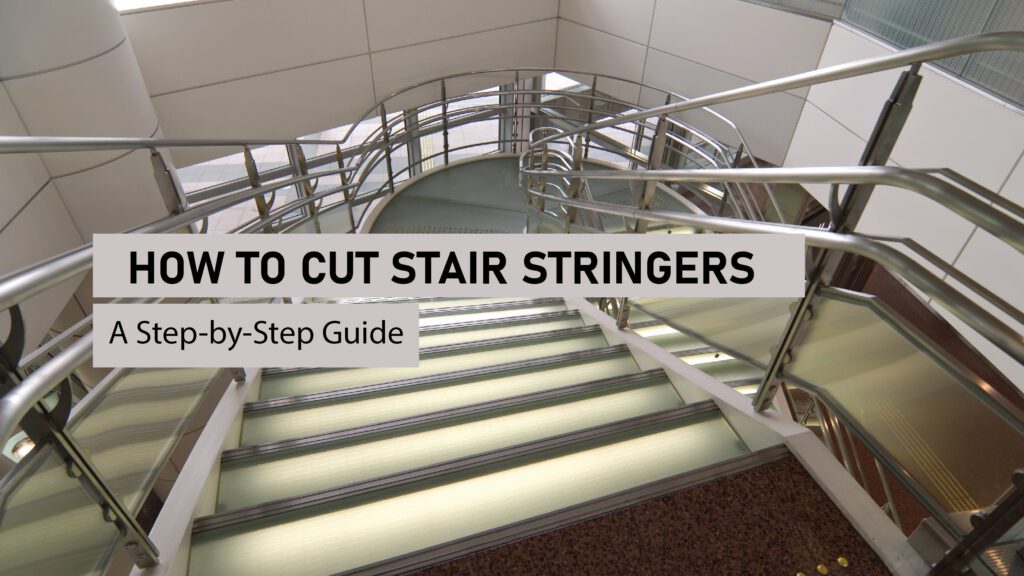How to Cut Stair Stringer: A Step-by-Step Guide
2 Comments

A staircase isn’t just steps; it’s a pathway that connects spaces and supports us as we move. The secret to a solid, secure staircase lies in the often unseen elements called stair stringers. Cutting these stringers accurately is crucial for a safe and durable staircase. Let’s dive into the steps of how to cut stair stringer.
What Are Stair Stringers?
Stair stringers are the slanted supports that hold up the stairs. They’re like the backbone of the stairs, running diagonally and supporting the steps you walk on. Stringers are usually placed on both sides of the stairs, and the steps are attached to them. They’re super important because they keep the stairs sturdy and safe to use.
Why Does Accuracy Matter in Cutting Stair Stringers?
Stringers, those inclined supports beneath the steps, bear the weight of each footfall. A well-cut stringer ensures uniform step height and depth, vital for safe and comfortable climbing. Precision matters to prevent uneven steps that could cause trips or falls.
Think about stairs like a ladder. Each step needs support to hold it up, right? Stringers are like the hidden heroes of stairs. They’re the strong, slanted parts under each step that help carry the weight when you walk up or down. They make sure each step stays the same size and distance apart, which is super important for safety and making sure it feels nice to climb.
When someone cuts the stringers just right, it means they’re making them really accurately. This accuracy is crucial because if the steps aren’t all the same, it could mess up your climb and make you trip or fall. So, making sure those stringers are spot-on is a big deal for keeping you safe and comfy on the stairs!
cutting stair stringers
How to Cut Stair Stringer Step-by-Step
Step 1: Gather Your Materials
First things first! Before you start working on the stairs, get everything you need together. Grab your tape for measuring, pencil for marking, and a square tool to check everything’s straight. Don’t forget a saw for cutting and safety glasses for eye protection. And don’t forget the wood you’ll use to make the stringers—that’s the main part! Having all this stuff ready will help you do the job properly and safely.
Hence, before diving in, gather the essentials: a measuring tape, pencil, framing square, saw, safety glasses, and, of course, the lumber for your stringers. If you’re wondering how to cut stair stringer for a deck, these tools will be your best friends in getting the job done accurately and safely.
Step 2: Measure the Total Rise and Run
Measure the vertical distance from the top of the finished floor to the height where the stairs will end. Also, determine the horizontal distance for the total run, from the edge of the upper floor to where the staircase will land.
Grab your measuring tape.
- First, measure how high you want the stairs to go, from the top of the floor where they start to where you want them to end. That’s the vertical distance, like climbing a ladder.
- Then, measure how far across the floor the stairs will stretch, from the edge where they begin to where they’ll stop.
That’s the horizontal distance, like how far you’d walk from one end of a room to another. These measurements help figure out how tall and wide the stairs need to be so they fit just right in the space you’ve got. Scaffolding accessories suppliers often rely on these measurements to ensure the stairs fit seamlessly within the scaffolding setup.
Step 3: Calculate the Number of Steps
Let’s figure out how many steps you’ll need for your stairs! Take the total height you measured earlier and divide it by a number that’s a good height for each step, usually between 7 and 8 inches. This helps decide how many steps will fit at that height.
Next, take the total length of the stairs and divide it by the number of steps you just figured out. This helps you find out how wide each step should be from side to side. It’s like making sure each step is the right size for you to comfortably walk on without feeling too cramped or stretched out.
Step 4: Lay Out and Mark Your Stringer
Grab that square tool and the measurements you got earlier. Take your piece of wood and start drawing lines on it using those measurements. First, draw lines to show how high each step will be (that’s the rise) and how wide each step will be (that’s the run). It’s like drawing a map for the stairs on the wood.
Be really careful and make sure these lines are right, showing where each step starts and stops. You’ll need to mark out the part you step on (that’s the tread depth) and the vertical parts in between each step (that’s the riser height). This way, when you start cutting, you’ll know exactly where to cut to make each step fit just right. It’s like drawing the blueprint for your stairs! Don’t forget to consider Steel Stair Stringers in your planning process for stability and support.
Step 5: Cut Along the Lines
Now comes the cutting stair stringer part! Make sure you’ve got your safety glasses on to protect your eyes. Take your saw and start cutting along those lines you drew on the wood earlier. It’s like following a map with your saw blade. Take it slow and steady, following those lines really carefully for each step.
Remember, the lines you drew are like the instructions for your saw. They show you exactly where to cut so that each step turns out just right. Cutting along these lines will shape the wood into the steps you’ve planned. Take your time and be precise—it’s all about making sure each step is the perfect size and shape.
Step 6: Test Fit and Adjust
Place the pre-cut stair stringers in position, ensuring they fit snugly. Check for levelness and make any necessary adjustments to the cuts for a perfect fit.
Put the piece of wood you cut (that’s the stringer) where it’s supposed to go. Make sure it fits nicely and feels solid. Check if it’s all straight and level, like making sure a table doesn’t wobble.
If something doesn’t seem quite right, don’t worry! You can fix it. Maybe some cuts need a little tweak here and there to make everything fit perfectly. It’s like putting a puzzle together—if a piece doesn’t fit, you adjust it until it does. Making these small changes will help the steps sit just right and make sure everything feels sturdy and safe when you climb up and down.
FAQ on Cutting Stair Stringers
How to cut stringers ?
Before you start cutting the stringers, you first have to measure the rise and run. Later, you have to figure out the number of steps and mark the stringers. You must cut along the lines shortly after drawing them.
How to measure and cut stair stringers?
After you have found out the number of steps, you need to cut the stair stringers using a square tool. You must begin drawing the lines as soon as you find a piece of wood. The first step is to draw the lines that indicate each step’s height. Additionally, you must mark according to the determined width.
How to cut stair stringers with a circular saw?
While you’re using a circular saw, you have to cut the stringers gradually. If the blade is not along the line, then you have to pull the saw back. As you come across two lines meeting at a 90 degree angle, you must stop cutting.
How to cut stair stringers for a deck?
When you wish to cut the stair stringer for a deck, you have to measure the total rise and the run. You must draw lines shortly after figuring out how many steps there are. Ultimately, you must carefully cut along the lines.
What is the formula for cutting stair stringers?
There’s no specific formula for cutting the stair stringers. But, if you want to cut them, then you have to follow some steps. Initially, you have to measure the total rise, find out the number of stairs, and calculate the height of every riser. Determining the run of every step is also essential before sketching out the stringers.
What is the best way to cut stair stringers?
To cut the stair stringers in the best way, you first need to mark the steps on the stringer. In addition, you must use a circular saw to cut along the lines. But, while you’re doing so, make sure you don’t overcut. You must stop once the lines intersect.
Should stair stringers be 2×10 or 2×12?
Ideally, the stair stringers must be 2×12 and not 2×10. This is because 2×12 lumber is quite strong and it has the capability of supporting heavy loads. Many people also prefer 2×12 lumber for the stair stringers.
What angle are stair stringers cut?
The angle at which stair stringers are cut depends on the type of stairs and their use. The most common angle for cutting residential stairs is 38 degrees. But, when you are about to set up stringers for industrial stairs, these can have a steeper angle between 40 and 70 degrees. On the other hand, the preferred angle is less for egress stairs.
Conclusion
This guide teaches you how to cut stair stringer step by step. Stringers are important parts of stairs. Accuracy matters a lot when making them. Each stage, from calculating the number of steps to the final adjustments, underscores the significance of methodical work.
Following this comprehensive guide equips both novices and seasoned builders alike with the knowledge needed to execute this task flawlessly, contributing to sturdy, secure staircases for any project.
Remember, it’s not just about crafting steps; it’s about crafting safety and reliability.
Why Choose AAIT For Stair Stringer Scaffolding?
AAIT offers a wide variety of scaffolding projects. This includes making, assembling, disassembling, testing, and keeping them in operation. Your project will be easier and faster with our all-in-one method.
Scaffold companies in Houston like AAIT offer high-quality scaffolding equipment and expertise. AAIT has extensive experience in various types of scaffolding projects, from small residential jobs to large commercial and industrial projects. As one of the best scaffolding accessories suppliers, AAIT emphasizes safety as a top priority, with trained and certified professionals, rigorous inspection procedures, and a commitment to following all safety regulations.
Don’t let your project hang in the balance—choose AAIT Scaffold and experience the difference!












 Download
Download